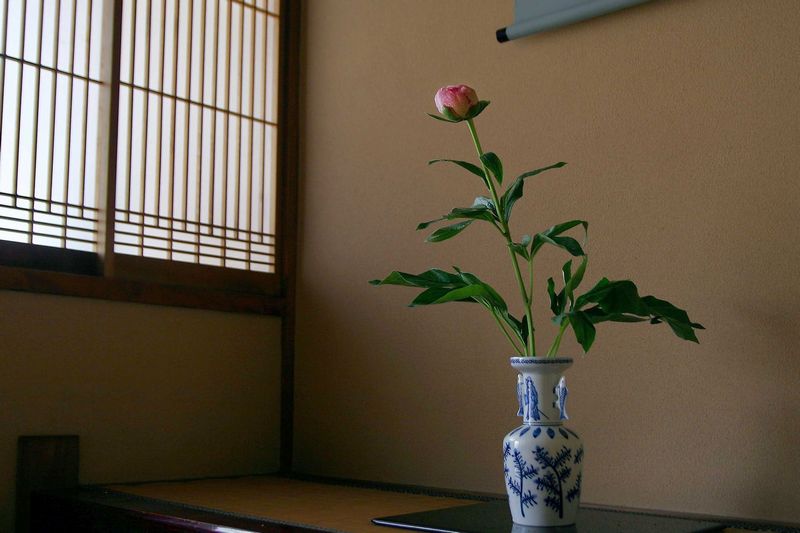Ikebana
Ikebana (生け花) is a Japanese term that refers to the art of flower arrangement, a practice now comparable to a real art that has very ancient origins in the history of Japan. Sometimes the word kadō (華道), literally "way of flowers" is used to express the same concept. With ikebana the purpose of the floral composition is not limited to a pure aesthetic factor, but goes further, starting from the process of creating the composition itself as a moment of research and expression of oneself.
Introduction and history of ikebana
For many centuries the art of flower arrangement had no particular significance, and flowers were simply placed in pots as votive offerings in temples. The origins of a more elaborate style are to be found in the Muromachi period (1336-1573), on the one hand in the development of the architectural style of houses and temples (shoin-zukuri), which began to include an alcove (today called tokonoma), embellished with art objects including the first floral compositions. On the other, in a set of three ceremonial objects placed in Buddhist altars, which included candelabra, a censer and flowers in a vase. The flowers in the vase began to be arranged in a style called
tatebana, influenced by Buddhist and Shinto beliefs and considered by historians to be a precursor of modern ikebana. In 1462
Senkei Ikenobo, a priest of the Rokkakudo temple in Kyoto, was invited by a warrior to arrange flowers, and these flowers were much appreciated by the people of the city for their beauty. It was at that moment that ikebana according to tradition was born.
Starting from the sixteenth century, this practice began to be called
rikka and was enriched with symbolism: the arrangement of each stem took on a symbolic meaning and the entire floral composition became a kind of microcosm that represented the whole universe. Nobles, priests, and even samurai warriors had a growing interest in this practice. During this period, the
chabana style ("flowers for tea") was also born, a simple and informal style that often used even a single flower, as an ornament in
tea ceremony rooms. The evolution of the practice and the birth of new styles continued in the following centuries.
 chabana
chabana
Currently, there are over three thousand different ikebana schools, with slightly different characteristics. For example, some schools argue that flowers should be arranged to look as if they are in the wild, while others pay attention to the precision of shapes and lines, even prescribing, in some cases, rules that dictate what kind of angles the branches should form. The Ikenobo, Sogetsu and Ohara schools are the most important nowadays. The Ikenobo style is the oldest and therefore the most classic. The Sogetsu style is the most modern and emphasizes self-expression. The Ohara style relies on tradition, but also pays particular attention to each season and flower to enhance its natural beauty, creating a modern interpretation of classic shapes.
Learn the art of ikebana in Japan
While wandering around Japan, you will come across some ikebana works in different places, such as museums, elegant restaurants and hotels, and tea houses.
Courses for tourists
If, on the other hand, you want to learn something about this artistic practice, various associations organize short courses of 2-3 hours in English for tourists. A typical course includes a historical introduction, an ikebana demonstration by an expert and finally you can test yourself, with the flowers and tools that are provided:
Ikebana schools
For those who want to seriously learn ikebana, you can refer to different schools, each of which teaches its own style. These offer even longer courses, over several days, and the lessons do not always take place every day or every week but only in certain periods. In particular:
- The Ohara school, with locations scattered throughout Japan, although in some locations the lessons are only in Japanese.
- The Sogetsu school, with one office in Tokyo and another in Kyoto.
Guided tours, activities and other things to do
If you are planning a trip to Japan and you want to do something more than just visiting famous places and monuments, we suggest you to use
Rakuten Travel Experiences.
How to use Rakuten Travel Experiences
Rakuten Travel is a very useful website to
enrich your travel experience, especially if you are going solo or it's your first time in Japan.
Because of the language barrier (and more), in Japan it is very difficult to interact with the locals and to get off the tourist track.
Thanks to Rakuten Travel you can find a lot of interesting and sometimes unique
guided tours and activities all over Japan (and not only in Japan), that you would otherwise never be able to enjoy.
But there's more: on Rakuten Travel you can also
buy tickets for several famous attractions, events, transportation and other useful services for tourists. Last but not least, you can
reserve a table in hundreds of restaurants.
Some examples
Take a look at Rakuten Travel Experiences
You may also be interested in